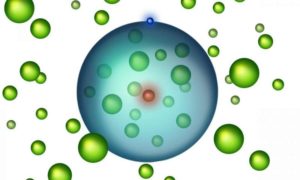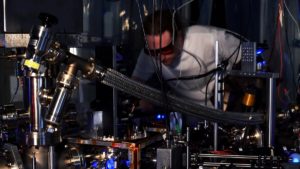The Rydberg Polaron : An Atom full of Atoms
Contents
An atom is made up of a nucleus and one or more electrons. Recall the structure of an atom from a high school textbook in which the electrons revolve around the nucleus. This brings up an idea that there is a space between the nucleus and the electron. But according to quantum mechanics, there exists an atomic orbital or an electron cloud where the electrons are present. Furthermore, have you ever wondered if you could possibly squeeze another atom into these empty spaces?
A team of US and Austrian researchers combined Bose-Einstein condensate studies with the creation of objects called Rydberg atoms . The team’s efforts centered around making, measuring and predicting the behaviour of a specific state of matter called a Rydberg polaron. This involved a combination of the above two distinct phenomena. The theorists at Vienna University of Technology and Harvard University proposed the Rydberg Polaron. The actual experiment and observation of this theory took place at Rice University in Houston, Texas.
What is Bose-Einstein condensate and Rydberg atoms?
A Bose-Einstein condensate is a state of matter of a dilute gas cooled to temperatures very close to absolute zero .
Rydberg atoms are those in which one single electron is lifted into a highly excited state and orbits the nucleus at a very large distance.
Polarons are created when a single particle interacts strongly with its environment. It causes the nearby electrons, ions or atoms to rearrange themselves. This is done to form a sort of coating that the particle carries with it. The polaron itself is a collective and unified object known as a quasiparticle that incorporates properties of the original particle and its environment.

Creation of Rydberg Polarons:
A Bose-Einstein condensate was created with strontium atoms. Energy was transferred using laser to one of these atoms, turning it into a Rydberg atom.The excited atom has a huge atomic radius. This radius of the orbit in which the electron moves around the nucleus is much larger than the typical distance between two atoms in the condensate. The average distance between the electron and its nucleus can be as large as several hundred nanometres. Therefore, the electron orbits its own atomic nucleus, while numerous other atoms lie inside its orbit, too. As many as 170 additional strontium atoms may be enclosed by the huge electronic orbit, consequently depending on the radius of the Rydberg atom and the density of the Bose-Einstein condensate.
The electrons do not carry any electric charge hence they do not exert any large force on the electron. The bond between the Rydberg atom and other atoms in the orbit is much weaker than that between atoms in a crystal. Furthermore, this exotic state of matter called Rydberg polarons can only be detected at very low temperatures. The bond would break if the particles were moving any faster. After all, the Rydberg polarons only exist for a few microseconds. But this behaviour could have important implications and even help make some other physics measurements.
“We have a completely new kind of atom where one electron runs around many atoms. There are hundreds of other atoms within the orbit of one nucleus. This is a very exotic picture different from the planetary model of the atom you learn about in high school.” Quoted by the study author Joachim Burgdörfer from TU Wien in Austria.
References:
- https://phys.org/news/2018-02-creation-rydberg-polarons-bose-gas.html
- https://phys.org/news/2018-02-physicists-bizarre-molecules-rydberg-polarons.html
- https://www.sciencealert.com/exotic-new-matter-rydberg-polaron-molecule-bose-einstein-condensate
- https://en.wikipedia.org/wiki/Rydberg_polaron
For more articles, click here
Written by Glavin Elsten Crasta



1 Comment
Octoroit Virtual OS Installation Walk-through · March 15, 2018 at 9:05 pm
I am glad to be one of the visitors on this great website (:, appreciate it for posting .